Organisational Culture and Workforce Motivation: Uber Company Analysis
VerifiedAdded on 2023/01/06
|9
|2553
|60
Report
AI Summary
This report provides an analysis of Uber's organizational culture and its impact on workforce motivation. It begins with an introduction to organizational behavior and culture, then explores Uber's vision, mission, and aims. The report examines team behavior within Uber, highlighting the influence of culture, power, and politics. It delves into Handy's typology model of culture, illustrating its effects on Uber's cultural development. Furthermore, the report discusses content and process theories, including Maslow's hierarchy of needs, Herzberg's two-factor theory, Elton Mayo's theory, and Vroom's expectancy theory, and how these theories can be used to improve employee effectiveness. The report concludes by emphasizing the importance of motivation in enhancing employee productivity and organizational performance, discussing how motivation can improve employee responsibility, relations, and trust within Uber. The report draws upon academic sources to support its arguments, providing a comprehensive overview of the topic.

Organisational
Cultures and Workforce
Motivation Company
Booklet assignment
Table of Contents
INTRODUCTION ..........................................................................................................................3
TASK 1............................................................................................................................................3
Cultures and Workforce
Motivation Company
Booklet assignment
Table of Contents
INTRODUCTION ..........................................................................................................................3
TASK 1............................................................................................................................................3
Paraphrase This Document
Need a fresh take? Get an instant paraphrase of this document with our AI Paraphraser
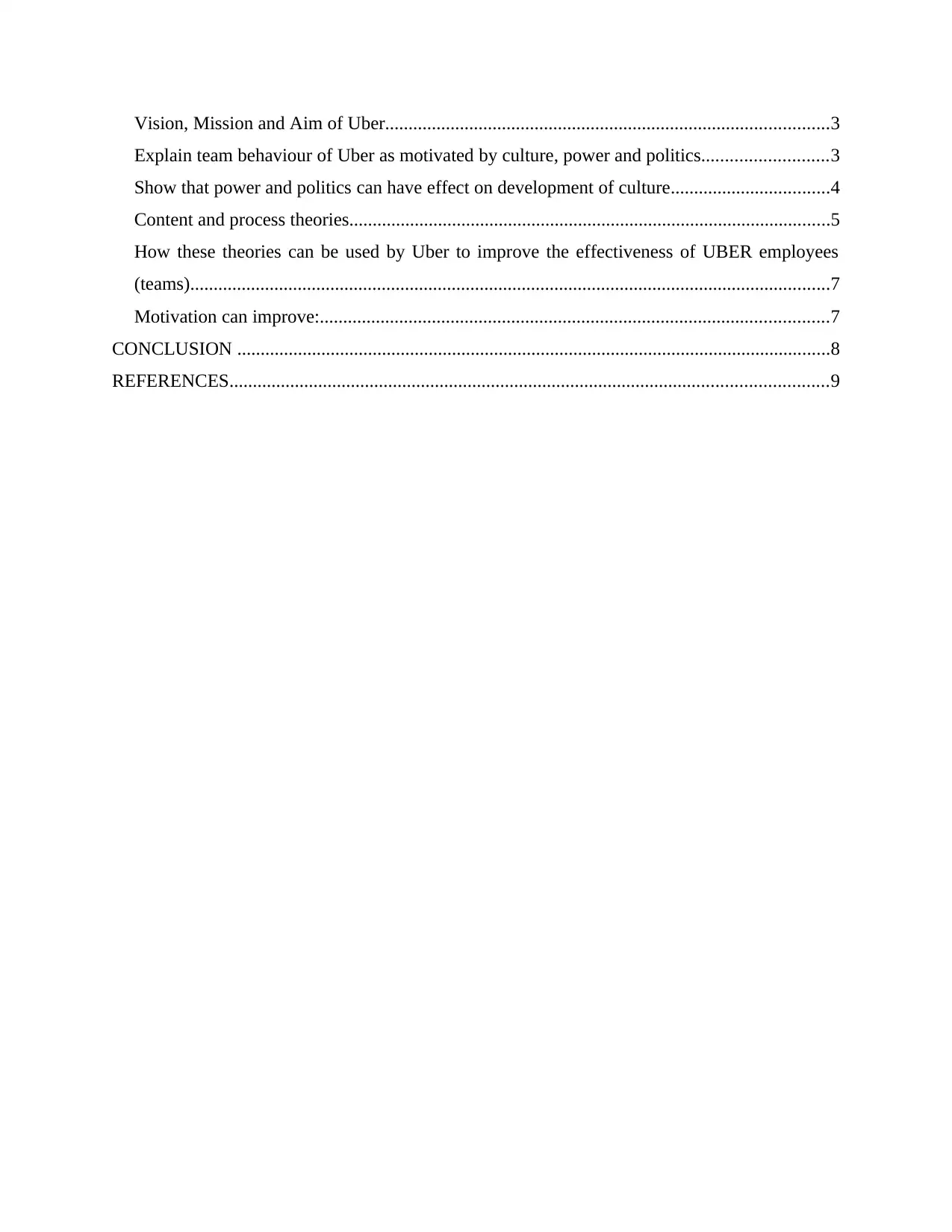
Vision, Mission and Aim of Uber...............................................................................................3
Explain team behaviour of Uber as motivated by culture, power and politics...........................3
Show that power and politics can have effect on development of culture..................................4
Content and process theories.......................................................................................................5
How these theories can be used by Uber to improve the effectiveness of UBER employees
(teams).........................................................................................................................................7
Motivation can improve:.............................................................................................................7
CONCLUSION ...............................................................................................................................8
REFERENCES................................................................................................................................9
Explain team behaviour of Uber as motivated by culture, power and politics...........................3
Show that power and politics can have effect on development of culture..................................4
Content and process theories.......................................................................................................5
How these theories can be used by Uber to improve the effectiveness of UBER employees
(teams).........................................................................................................................................7
Motivation can improve:.............................................................................................................7
CONCLUSION ...............................................................................................................................8
REFERENCES................................................................................................................................9
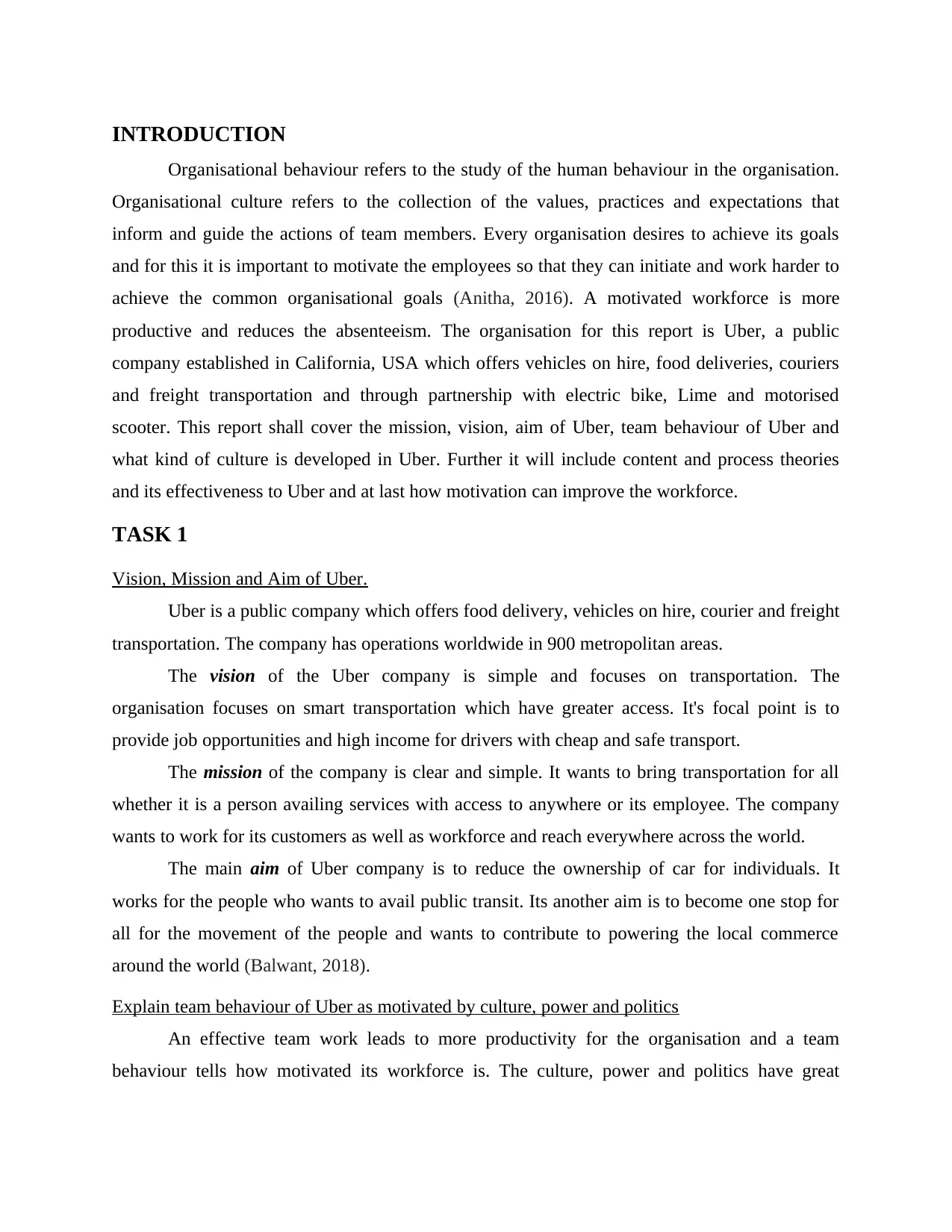
INTRODUCTION
Organisational behaviour refers to the study of the human behaviour in the organisation.
Organisational culture refers to the collection of the values, practices and expectations that
inform and guide the actions of team members. Every organisation desires to achieve its goals
and for this it is important to motivate the employees so that they can initiate and work harder to
achieve the common organisational goals (Anitha, 2016). A motivated workforce is more
productive and reduces the absenteeism. The organisation for this report is Uber, a public
company established in California, USA which offers vehicles on hire, food deliveries, couriers
and freight transportation and through partnership with electric bike, Lime and motorised
scooter. This report shall cover the mission, vision, aim of Uber, team behaviour of Uber and
what kind of culture is developed in Uber. Further it will include content and process theories
and its effectiveness to Uber and at last how motivation can improve the workforce.
TASK 1
Vision, Mission and Aim of Uber.
Uber is a public company which offers food delivery, vehicles on hire, courier and freight
transportation. The company has operations worldwide in 900 metropolitan areas.
The vision of the Uber company is simple and focuses on transportation. The
organisation focuses on smart transportation which have greater access. It's focal point is to
provide job opportunities and high income for drivers with cheap and safe transport.
The mission of the company is clear and simple. It wants to bring transportation for all
whether it is a person availing services with access to anywhere or its employee. The company
wants to work for its customers as well as workforce and reach everywhere across the world.
The main aim of Uber company is to reduce the ownership of car for individuals. It
works for the people who wants to avail public transit. Its another aim is to become one stop for
all for the movement of the people and wants to contribute to powering the local commerce
around the world (Balwant, 2018).
Explain team behaviour of Uber as motivated by culture, power and politics
An effective team work leads to more productivity for the organisation and a team
behaviour tells how motivated its workforce is. The culture, power and politics have great
Organisational behaviour refers to the study of the human behaviour in the organisation.
Organisational culture refers to the collection of the values, practices and expectations that
inform and guide the actions of team members. Every organisation desires to achieve its goals
and for this it is important to motivate the employees so that they can initiate and work harder to
achieve the common organisational goals (Anitha, 2016). A motivated workforce is more
productive and reduces the absenteeism. The organisation for this report is Uber, a public
company established in California, USA which offers vehicles on hire, food deliveries, couriers
and freight transportation and through partnership with electric bike, Lime and motorised
scooter. This report shall cover the mission, vision, aim of Uber, team behaviour of Uber and
what kind of culture is developed in Uber. Further it will include content and process theories
and its effectiveness to Uber and at last how motivation can improve the workforce.
TASK 1
Vision, Mission and Aim of Uber.
Uber is a public company which offers food delivery, vehicles on hire, courier and freight
transportation. The company has operations worldwide in 900 metropolitan areas.
The vision of the Uber company is simple and focuses on transportation. The
organisation focuses on smart transportation which have greater access. It's focal point is to
provide job opportunities and high income for drivers with cheap and safe transport.
The mission of the company is clear and simple. It wants to bring transportation for all
whether it is a person availing services with access to anywhere or its employee. The company
wants to work for its customers as well as workforce and reach everywhere across the world.
The main aim of Uber company is to reduce the ownership of car for individuals. It
works for the people who wants to avail public transit. Its another aim is to become one stop for
all for the movement of the people and wants to contribute to powering the local commerce
around the world (Balwant, 2018).
Explain team behaviour of Uber as motivated by culture, power and politics
An effective team work leads to more productivity for the organisation and a team
behaviour tells how motivated its workforce is. The culture, power and politics have great
⊘ This is a preview!⊘
Do you want full access?
Subscribe today to unlock all pages.

Trusted by 1+ million students worldwide

influence over the team behaviour which ultimately affects the work of the team. The team
behaviour of Uber is motivated by its culture, power and politics in following ways-
Culture- It refers to the way things are done around the workplace. Uber company value
its employees and appreciate the ideas of the workforce. The teams are build according to
the skills and every member motivate other to work effectively. So the culture of the
company helps in motivating teams to work efficiently.
Power- It refers to the ability to influence the behaviour of other or exert the control.
Uber follows democratic style of working where every person is free to speak and put on
its opinion. Everyone's idea is welcomed and the organisation focuses more on
converting the concepts to actions so that there is growth of Uber. So power does not
control or influence the team behaviour.
Politics- It refers to the activities which are involved in governing the people. The
environment of the company is highly positive to motivate employees to work harder
(Habba and et. al., 2017). The employer assign the task according to the ability and skill
of the employee so that its inner strength is improved. So this motivates the team
behaviour of Uber.
Show that power and politics can have effect on development of culture
In Uber Handy's typology model of culture is being used which are having major impact
in their cultural development. Explanation of this model is as under:
Power culture: Under this power is hold by influential person so as to spread power
within whole the organisation in order to manage functions in effective manner. In the context of
Uber as the company is associated with robust management system but at the same time power is
being rendered to higher level authority in order to eliminate situation of mismanagement.
Role culture: Under this culture organisations are based on rules and roles. Similarly
organisations are controlled by set of structures and detailed command. In the reference of Uber
this culture is drawing negative impact on decision making as process of decision making get
tangled which results in delays.
Task culture: These culture situations are based on a particular project. Under this
culture power to take decision get shifted as according to the nature of project. In the context of
Uber task culture is performed in the presence of new project by which dynamic and creativity
can be ascertained by team members.
behaviour of Uber is motivated by its culture, power and politics in following ways-
Culture- It refers to the way things are done around the workplace. Uber company value
its employees and appreciate the ideas of the workforce. The teams are build according to
the skills and every member motivate other to work effectively. So the culture of the
company helps in motivating teams to work efficiently.
Power- It refers to the ability to influence the behaviour of other or exert the control.
Uber follows democratic style of working where every person is free to speak and put on
its opinion. Everyone's idea is welcomed and the organisation focuses more on
converting the concepts to actions so that there is growth of Uber. So power does not
control or influence the team behaviour.
Politics- It refers to the activities which are involved in governing the people. The
environment of the company is highly positive to motivate employees to work harder
(Habba and et. al., 2017). The employer assign the task according to the ability and skill
of the employee so that its inner strength is improved. So this motivates the team
behaviour of Uber.
Show that power and politics can have effect on development of culture
In Uber Handy's typology model of culture is being used which are having major impact
in their cultural development. Explanation of this model is as under:
Power culture: Under this power is hold by influential person so as to spread power
within whole the organisation in order to manage functions in effective manner. In the context of
Uber as the company is associated with robust management system but at the same time power is
being rendered to higher level authority in order to eliminate situation of mismanagement.
Role culture: Under this culture organisations are based on rules and roles. Similarly
organisations are controlled by set of structures and detailed command. In the reference of Uber
this culture is drawing negative impact on decision making as process of decision making get
tangled which results in delays.
Task culture: These culture situations are based on a particular project. Under this
culture power to take decision get shifted as according to the nature of project. In the context of
Uber task culture is performed in the presence of new project by which dynamic and creativity
can be ascertained by team members.
Paraphrase This Document
Need a fresh take? Get an instant paraphrase of this document with our AI Paraphraser

Person culture: Under this culture an individual sees themselves as laced with distinct
aspect. In the context of Uber professional individual like accountant, lawyers are lies under this
group as their tasks are independent from each other (Albardiaz, 2017).
Content and process theories
The Maslow's hierarchy of needs-
It is a content theory which states that every human shares same type of needs and these
needs are categorised into hierarchy. From needs of surviving to needs of fulfilling the potential
and purpose of life, all types of needs are covered under this theory. There is a pyramid of needs
and an individual has to fully meet its need at current level so that it gets motivated to achieve
the next level need.
The basic and first level need is Physiological needs which are necessary to survive as
they are aspirational needs of life like food, shelter, clothing. The second level of need is the
safety needs for which a person is motivated after achieving the first level needs which helps in
removing risk from life and helps in maintaining the physiological needs. The third need is social
belonging needs for which an individual is motivated after attaining first and second level need.
The person becomes pursuit of the social belongings when its basic needs are fulfilled. The
fourth level need is self esteem which is to be achieved after above three needs are fulfilled and
an individual starts focusing on itself and its self esteem. These are build for satisfying the ego of
the person. The final level need is self actualization needs which is to be attained by an
individual after his above four needs are fulfilled. It makes the person feel like it wants to fulfil
its potential and abilities.
Herzberg's two factor theory
This is a content theory of motivation which states that different factors create the
satisfaction and dissatisfaction in the work. One is the motivating factor which have the ability to
satisfy an individual and other is the hygiene factor which may make an individual unsatisfied or
unhappy but alone its presence cannot satisfy a person from work. Hygiene factors include
safety, salary, working environment, security, etc. (Hattie, Hodis and Kang, 2020). The
motivating factors have no impact on motivating the people if hygiene factors are not present.
Motivating factors include recognition, achievement, empowerment, responsibility, etc.
Elton Mayo's motivation theory
aspect. In the context of Uber professional individual like accountant, lawyers are lies under this
group as their tasks are independent from each other (Albardiaz, 2017).
Content and process theories
The Maslow's hierarchy of needs-
It is a content theory which states that every human shares same type of needs and these
needs are categorised into hierarchy. From needs of surviving to needs of fulfilling the potential
and purpose of life, all types of needs are covered under this theory. There is a pyramid of needs
and an individual has to fully meet its need at current level so that it gets motivated to achieve
the next level need.
The basic and first level need is Physiological needs which are necessary to survive as
they are aspirational needs of life like food, shelter, clothing. The second level of need is the
safety needs for which a person is motivated after achieving the first level needs which helps in
removing risk from life and helps in maintaining the physiological needs. The third need is social
belonging needs for which an individual is motivated after attaining first and second level need.
The person becomes pursuit of the social belongings when its basic needs are fulfilled. The
fourth level need is self esteem which is to be achieved after above three needs are fulfilled and
an individual starts focusing on itself and its self esteem. These are build for satisfying the ego of
the person. The final level need is self actualization needs which is to be attained by an
individual after his above four needs are fulfilled. It makes the person feel like it wants to fulfil
its potential and abilities.
Herzberg's two factor theory
This is a content theory of motivation which states that different factors create the
satisfaction and dissatisfaction in the work. One is the motivating factor which have the ability to
satisfy an individual and other is the hygiene factor which may make an individual unsatisfied or
unhappy but alone its presence cannot satisfy a person from work. Hygiene factors include
safety, salary, working environment, security, etc. (Hattie, Hodis and Kang, 2020). The
motivating factors have no impact on motivating the people if hygiene factors are not present.
Motivating factors include recognition, achievement, empowerment, responsibility, etc.
Elton Mayo's motivation theory
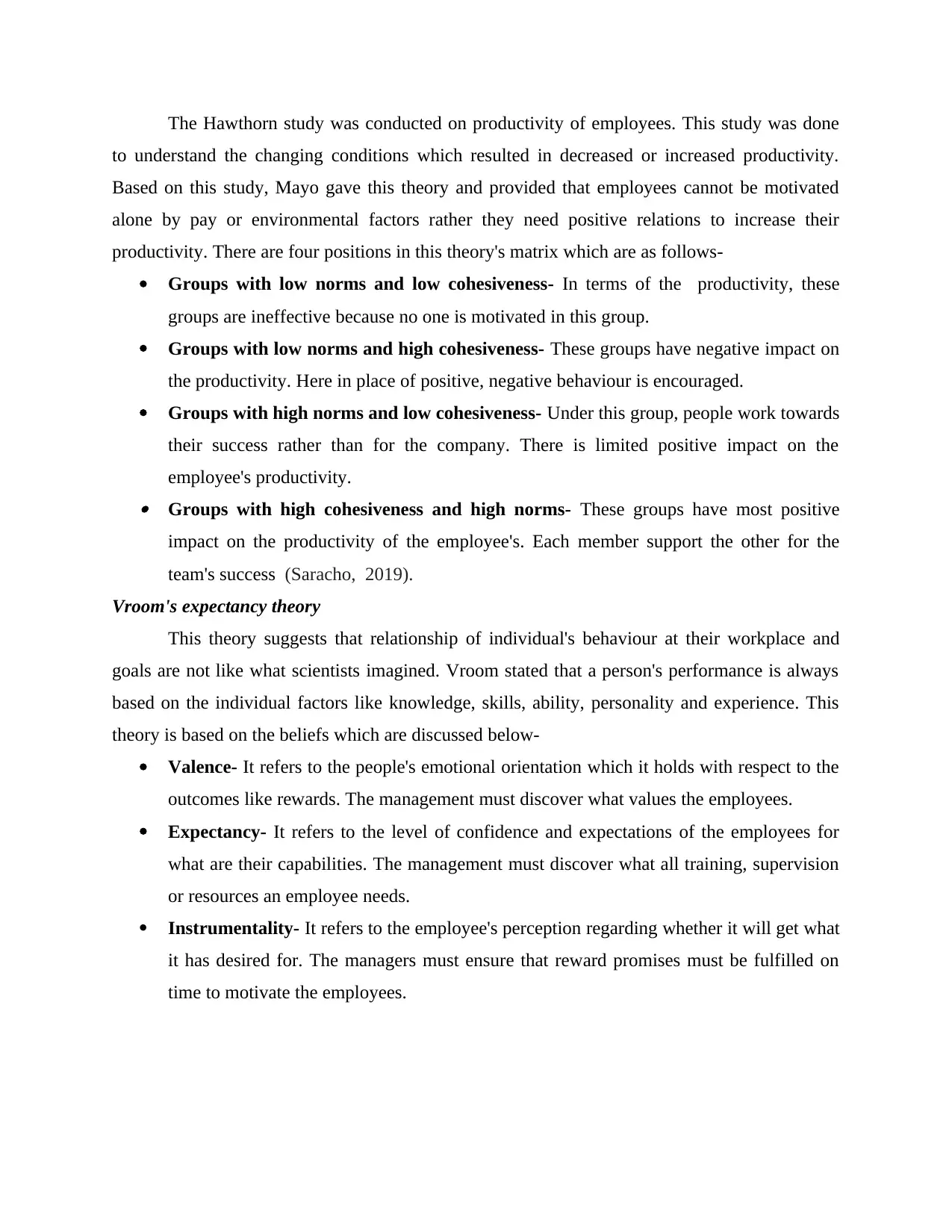
The Hawthorn study was conducted on productivity of employees. This study was done
to understand the changing conditions which resulted in decreased or increased productivity.
Based on this study, Mayo gave this theory and provided that employees cannot be motivated
alone by pay or environmental factors rather they need positive relations to increase their
productivity. There are four positions in this theory's matrix which are as follows-
Groups with low norms and low cohesiveness- In terms of the productivity, these
groups are ineffective because no one is motivated in this group.
Groups with low norms and high cohesiveness- These groups have negative impact on
the productivity. Here in place of positive, negative behaviour is encouraged.
Groups with high norms and low cohesiveness- Under this group, people work towards
their success rather than for the company. There is limited positive impact on the
employee's productivity. Groups with high cohesiveness and high norms- These groups have most positive
impact on the productivity of the employee's. Each member support the other for the
team's success (Saracho, 2019).
Vroom's expectancy theory
This theory suggests that relationship of individual's behaviour at their workplace and
goals are not like what scientists imagined. Vroom stated that a person's performance is always
based on the individual factors like knowledge, skills, ability, personality and experience. This
theory is based on the beliefs which are discussed below-
Valence- It refers to the people's emotional orientation which it holds with respect to the
outcomes like rewards. The management must discover what values the employees.
Expectancy- It refers to the level of confidence and expectations of the employees for
what are their capabilities. The management must discover what all training, supervision
or resources an employee needs.
Instrumentality- It refers to the employee's perception regarding whether it will get what
it has desired for. The managers must ensure that reward promises must be fulfilled on
time to motivate the employees.
to understand the changing conditions which resulted in decreased or increased productivity.
Based on this study, Mayo gave this theory and provided that employees cannot be motivated
alone by pay or environmental factors rather they need positive relations to increase their
productivity. There are four positions in this theory's matrix which are as follows-
Groups with low norms and low cohesiveness- In terms of the productivity, these
groups are ineffective because no one is motivated in this group.
Groups with low norms and high cohesiveness- These groups have negative impact on
the productivity. Here in place of positive, negative behaviour is encouraged.
Groups with high norms and low cohesiveness- Under this group, people work towards
their success rather than for the company. There is limited positive impact on the
employee's productivity. Groups with high cohesiveness and high norms- These groups have most positive
impact on the productivity of the employee's. Each member support the other for the
team's success (Saracho, 2019).
Vroom's expectancy theory
This theory suggests that relationship of individual's behaviour at their workplace and
goals are not like what scientists imagined. Vroom stated that a person's performance is always
based on the individual factors like knowledge, skills, ability, personality and experience. This
theory is based on the beliefs which are discussed below-
Valence- It refers to the people's emotional orientation which it holds with respect to the
outcomes like rewards. The management must discover what values the employees.
Expectancy- It refers to the level of confidence and expectations of the employees for
what are their capabilities. The management must discover what all training, supervision
or resources an employee needs.
Instrumentality- It refers to the employee's perception regarding whether it will get what
it has desired for. The managers must ensure that reward promises must be fulfilled on
time to motivate the employees.
⊘ This is a preview!⊘
Do you want full access?
Subscribe today to unlock all pages.

Trusted by 1+ million students worldwide
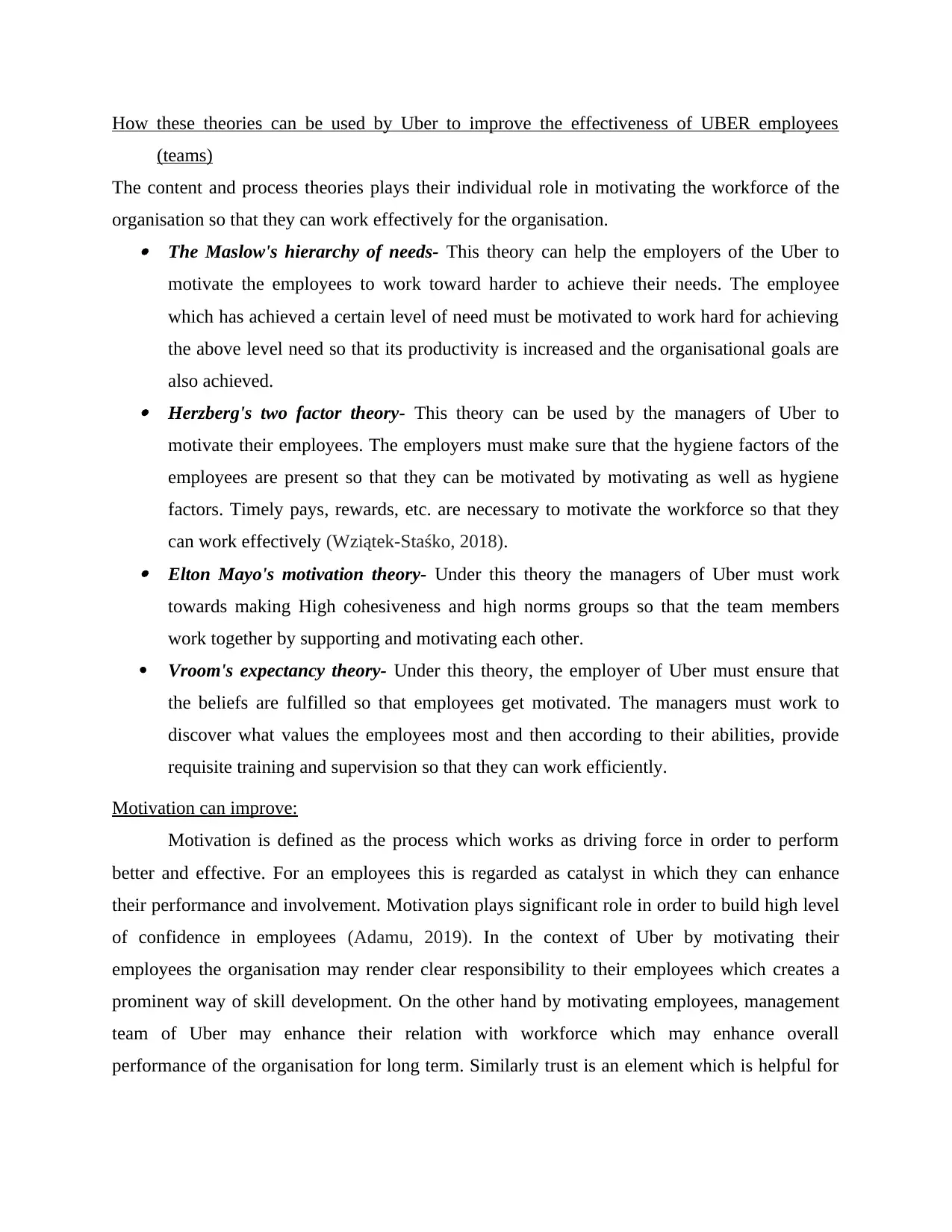
How these theories can be used by Uber to improve the effectiveness of UBER employees
(teams)
The content and process theories plays their individual role in motivating the workforce of the
organisation so that they can work effectively for the organisation. The Maslow's hierarchy of needs- This theory can help the employers of the Uber to
motivate the employees to work toward harder to achieve their needs. The employee
which has achieved a certain level of need must be motivated to work hard for achieving
the above level need so that its productivity is increased and the organisational goals are
also achieved. Herzberg's two factor theory- This theory can be used by the managers of Uber to
motivate their employees. The employers must make sure that the hygiene factors of the
employees are present so that they can be motivated by motivating as well as hygiene
factors. Timely pays, rewards, etc. are necessary to motivate the workforce so that they
can work effectively (Wziątek-Staśko, 2018). Elton Mayo's motivation theory- Under this theory the managers of Uber must work
towards making High cohesiveness and high norms groups so that the team members
work together by supporting and motivating each other.
Vroom's expectancy theory- Under this theory, the employer of Uber must ensure that
the beliefs are fulfilled so that employees get motivated. The managers must work to
discover what values the employees most and then according to their abilities, provide
requisite training and supervision so that they can work efficiently.
Motivation can improve:
Motivation is defined as the process which works as driving force in order to perform
better and effective. For an employees this is regarded as catalyst in which they can enhance
their performance and involvement. Motivation plays significant role in order to build high level
of confidence in employees (Adamu, 2019). In the context of Uber by motivating their
employees the organisation may render clear responsibility to their employees which creates a
prominent way of skill development. On the other hand by motivating employees, management
team of Uber may enhance their relation with workforce which may enhance overall
performance of the organisation for long term. Similarly trust is an element which is helpful for
(teams)
The content and process theories plays their individual role in motivating the workforce of the
organisation so that they can work effectively for the organisation. The Maslow's hierarchy of needs- This theory can help the employers of the Uber to
motivate the employees to work toward harder to achieve their needs. The employee
which has achieved a certain level of need must be motivated to work hard for achieving
the above level need so that its productivity is increased and the organisational goals are
also achieved. Herzberg's two factor theory- This theory can be used by the managers of Uber to
motivate their employees. The employers must make sure that the hygiene factors of the
employees are present so that they can be motivated by motivating as well as hygiene
factors. Timely pays, rewards, etc. are necessary to motivate the workforce so that they
can work effectively (Wziątek-Staśko, 2018). Elton Mayo's motivation theory- Under this theory the managers of Uber must work
towards making High cohesiveness and high norms groups so that the team members
work together by supporting and motivating each other.
Vroom's expectancy theory- Under this theory, the employer of Uber must ensure that
the beliefs are fulfilled so that employees get motivated. The managers must work to
discover what values the employees most and then according to their abilities, provide
requisite training and supervision so that they can work efficiently.
Motivation can improve:
Motivation is defined as the process which works as driving force in order to perform
better and effective. For an employees this is regarded as catalyst in which they can enhance
their performance and involvement. Motivation plays significant role in order to build high level
of confidence in employees (Adamu, 2019). In the context of Uber by motivating their
employees the organisation may render clear responsibility to their employees which creates a
prominent way of skill development. On the other hand by motivating employees, management
team of Uber may enhance their relation with workforce which may enhance overall
performance of the organisation for long term. Similarly trust is an element which is helpful for
Paraphrase This Document
Need a fresh take? Get an instant paraphrase of this document with our AI Paraphraser
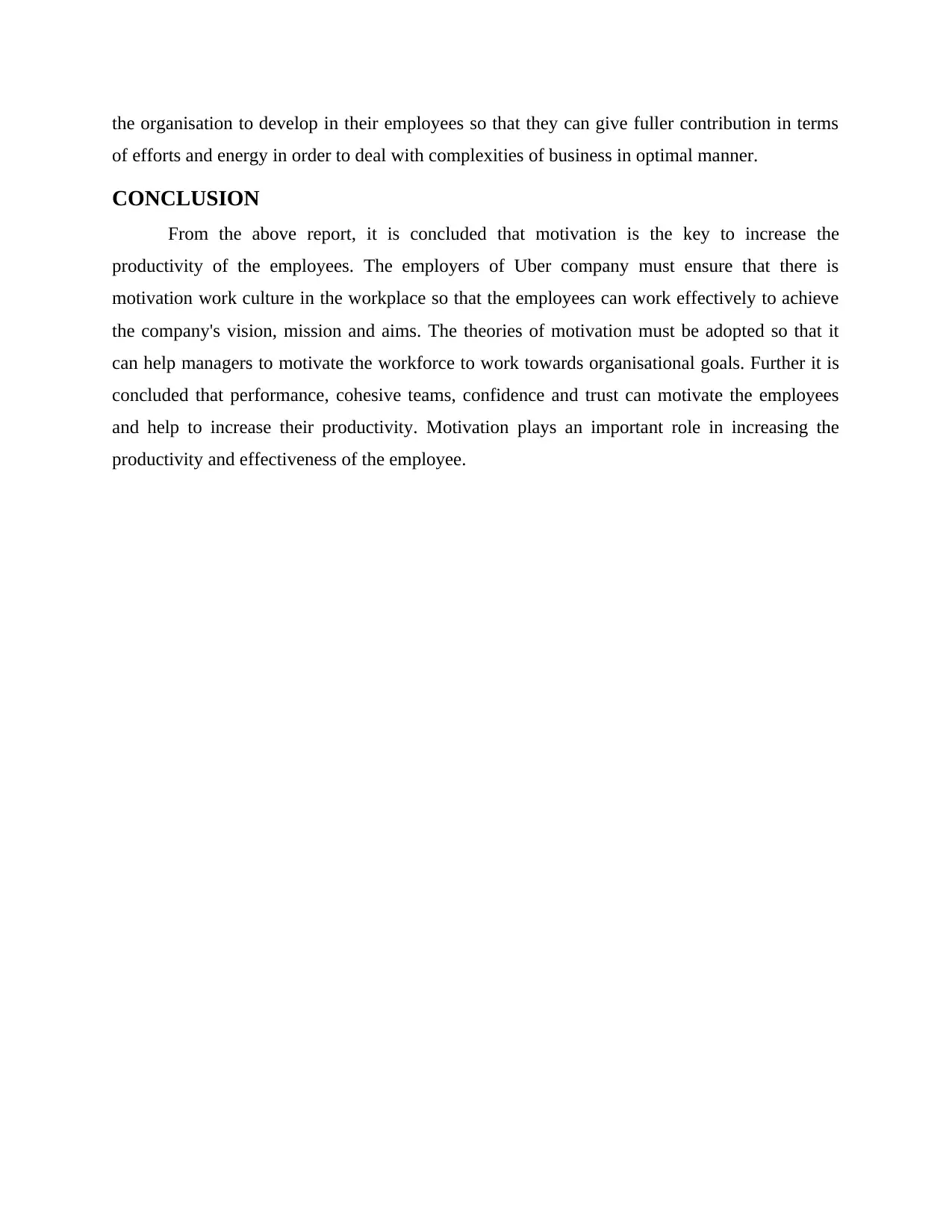
the organisation to develop in their employees so that they can give fuller contribution in terms
of efforts and energy in order to deal with complexities of business in optimal manner.
CONCLUSION
From the above report, it is concluded that motivation is the key to increase the
productivity of the employees. The employers of Uber company must ensure that there is
motivation work culture in the workplace so that the employees can work effectively to achieve
the company's vision, mission and aims. The theories of motivation must be adopted so that it
can help managers to motivate the workforce to work towards organisational goals. Further it is
concluded that performance, cohesive teams, confidence and trust can motivate the employees
and help to increase their productivity. Motivation plays an important role in increasing the
productivity and effectiveness of the employee.
of efforts and energy in order to deal with complexities of business in optimal manner.
CONCLUSION
From the above report, it is concluded that motivation is the key to increase the
productivity of the employees. The employers of Uber company must ensure that there is
motivation work culture in the workplace so that the employees can work effectively to achieve
the company's vision, mission and aims. The theories of motivation must be adopted so that it
can help managers to motivate the workforce to work towards organisational goals. Further it is
concluded that performance, cohesive teams, confidence and trust can motivate the employees
and help to increase their productivity. Motivation plays an important role in increasing the
productivity and effectiveness of the employee.
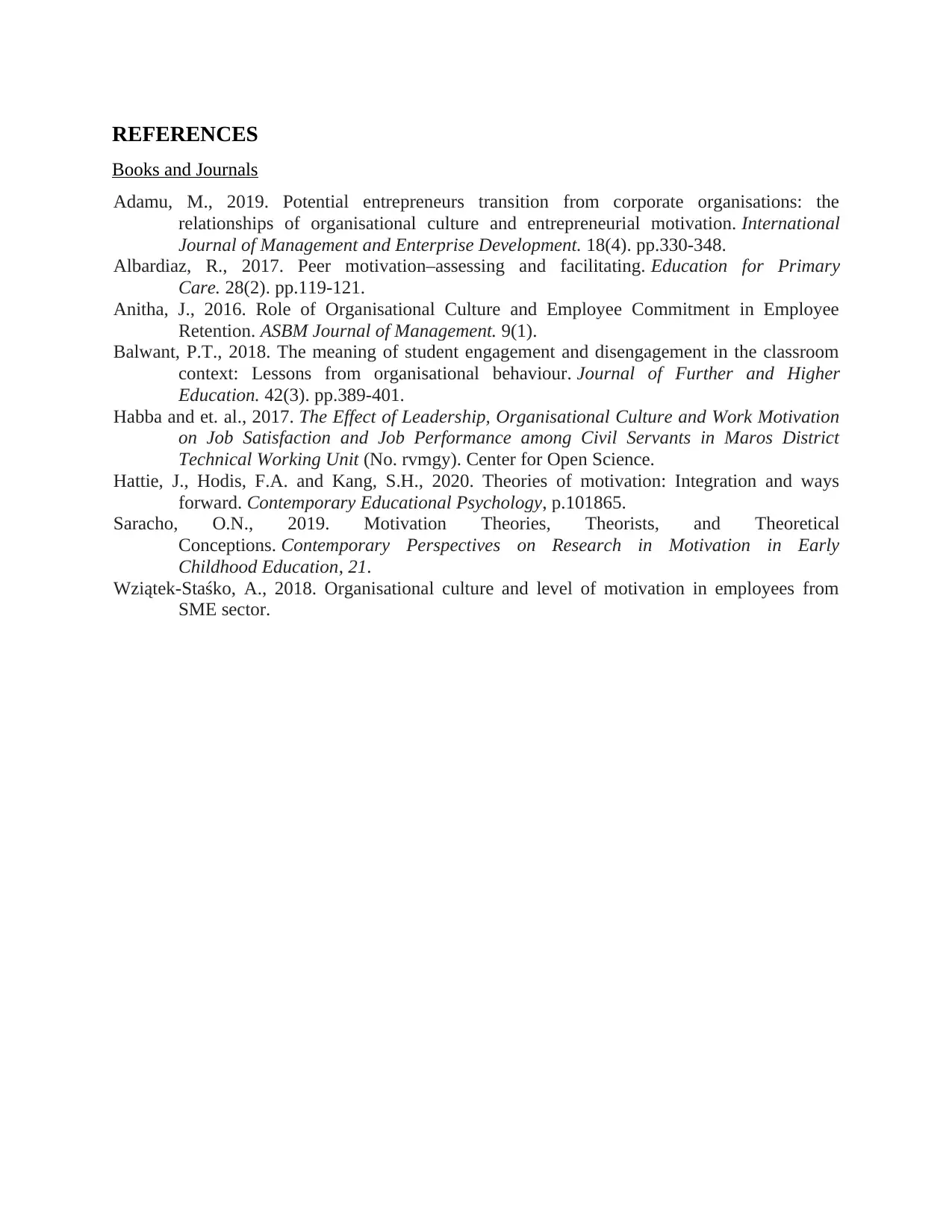
REFERENCES
Books and Journals
Adamu, M., 2019. Potential entrepreneurs transition from corporate organisations: the
relationships of organisational culture and entrepreneurial motivation. International
Journal of Management and Enterprise Development. 18(4). pp.330-348.
Albardiaz, R., 2017. Peer motivation–assessing and facilitating. Education for Primary
Care. 28(2). pp.119-121.
Anitha, J., 2016. Role of Organisational Culture and Employee Commitment in Employee
Retention. ASBM Journal of Management. 9(1).
Balwant, P.T., 2018. The meaning of student engagement and disengagement in the classroom
context: Lessons from organisational behaviour. Journal of Further and Higher
Education. 42(3). pp.389-401.
Habba and et. al., 2017. The Effect of Leadership, Organisational Culture and Work Motivation
on Job Satisfaction and Job Performance among Civil Servants in Maros District
Technical Working Unit (No. rvmgy). Center for Open Science.
Hattie, J., Hodis, F.A. and Kang, S.H., 2020. Theories of motivation: Integration and ways
forward. Contemporary Educational Psychology, p.101865.
Saracho, O.N., 2019. Motivation Theories, Theorists, and Theoretical
Conceptions. Contemporary Perspectives on Research in Motivation in Early
Childhood Education, 21.
Wziątek-Staśko, A., 2018. Organisational culture and level of motivation in employees from
SME sector.
Books and Journals
Adamu, M., 2019. Potential entrepreneurs transition from corporate organisations: the
relationships of organisational culture and entrepreneurial motivation. International
Journal of Management and Enterprise Development. 18(4). pp.330-348.
Albardiaz, R., 2017. Peer motivation–assessing and facilitating. Education for Primary
Care. 28(2). pp.119-121.
Anitha, J., 2016. Role of Organisational Culture and Employee Commitment in Employee
Retention. ASBM Journal of Management. 9(1).
Balwant, P.T., 2018. The meaning of student engagement and disengagement in the classroom
context: Lessons from organisational behaviour. Journal of Further and Higher
Education. 42(3). pp.389-401.
Habba and et. al., 2017. The Effect of Leadership, Organisational Culture and Work Motivation
on Job Satisfaction and Job Performance among Civil Servants in Maros District
Technical Working Unit (No. rvmgy). Center for Open Science.
Hattie, J., Hodis, F.A. and Kang, S.H., 2020. Theories of motivation: Integration and ways
forward. Contemporary Educational Psychology, p.101865.
Saracho, O.N., 2019. Motivation Theories, Theorists, and Theoretical
Conceptions. Contemporary Perspectives on Research in Motivation in Early
Childhood Education, 21.
Wziątek-Staśko, A., 2018. Organisational culture and level of motivation in employees from
SME sector.
⊘ This is a preview!⊘
Do you want full access?
Subscribe today to unlock all pages.

Trusted by 1+ million students worldwide
1 out of 9
Related Documents
Your All-in-One AI-Powered Toolkit for Academic Success.
+13062052269
info@desklib.com
Available 24*7 on WhatsApp / Email
![[object Object]](/_next/static/media/star-bottom.7253800d.svg)
Unlock your academic potential
Copyright © 2020–2025 A2Z Services. All Rights Reserved. Developed and managed by ZUCOL.





